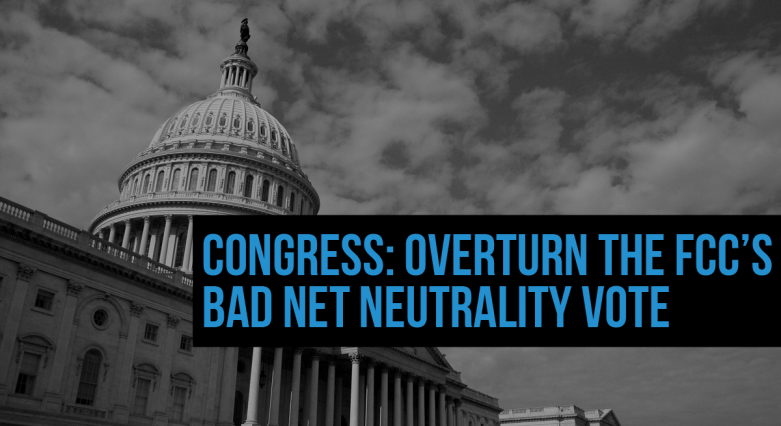
How Congress Can Save Net Neutrality: A Step-by-Step Breakdown
If you’re passionate about Net Neutrality, you may be wondering what we can do now that the FCC has voted to repeal the rules protecting it.
You may have even heard that Congress is the next venue in the fight. But what exactly can Congress do?
Lawmakers can overturn the FCC’s vote. Using the Congressional Review Act (CRA), a previously obscure regulation that’s been all the rage this year in Washington, Congress can use a fast-track legislative process to review and reverse new decisions from federal agencies.
In other words, Congress could use the CRA to pass a resolution rejecting what this FCC has done. That resolution of disapproval would overturn last week’s vote and restore the strong Net Neutrality protections we won in 2015, including the firm legal grounding of Title II.
Here’s a quick look at how that process would work:
1. FCC starts the clock: The FCC voted to repeal Net Neutrality, but it still has to publish the rules in the Federal Register and take other steps to get final approval for its decision. Once all of that happens, Congress has 60 “legislative days” to pass a joint resolution of disapproval using the CRA.
2. Get through relevant committees: Once members of the House and Senate introduce a resolution, it then makes its way through the appropriate committees in each chamber. Good news: If majority leaders try to prevent a vote, there are ways for a simple majority of the House — or even just 30 senators — to push past them and still get the resolution to the floor.
3. Win a majority: The Senate can’t filibuster a joint resolution of disapproval. There’s a limited amount of time set aside for debate, and it needs only a simple majority to pass in the Senate (not the 60 votes often required to move ahead with a vote).
This year we’ve already seen lawmakers from both sides of the aisle speak up in support of maintaining the FCC’s strong Net Neutrality rules, so a victory is within reach — even with Congress controlled by Republican leadership that’s been hostile to internet-freedom concerns (plus a whole range of other economic, social and racial-justice issues).
4. Sign the resolution: Once passed, the joint resolution heads to Trump’s desk. If the president ignores the will of millions of constituents from both ends of the political spectrum and takes a hard stand against Net Neutrality by vetoing this resolution, don’t worry: Free Press and our allies will sue the FCC — as will attorneys general across the nation.
What you can do: Make it utterly toxic for politicians to oppose Title II Net Neutrality. That means calling out any lawmaker who hasn’t made an unequivocal public statement of support. Visit the scoreboard at BattleForTheNet to see where your lawmaker stands, then get your community to take action.
Make sure that everyone you know is talking about the importance of the open internet — especially for people of color and other marginalized communities. Together, we can motivate Congress to protect our digital civil rights.